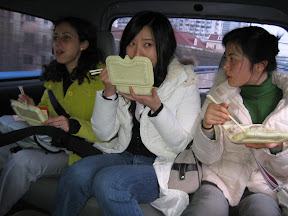Forging university relationships

One of the main reasons why I work for IDEO is because the company believes in strong university relations. I’m not talking about purely fostering university relations for the sake of recruiting, but the simple fact that we can learn a lot by spending time with professors and students, teaching and mentoring.
On Thursday, a gaggle of us went with Opher to JiaoTong University outside of Shanghai to break ground in our efforts to start working with Chinese universities. JiaoTong is one of the most well known universities in China, alongside BeiDa and TsingHua (both in Beijing) and Fudan University, which is also in Shanghai. Our very own Andy Xu and Tony Zhou are JiaoTong alumni.
IDEO Shanghai was introduced to a group of design professors at JiaoTong through our dearest Stanford Professor Bernie Roth, whose name will make Ela and I cringe from memories of trajectory math. I was impressed at how forward-thinking and open-minded these multidisciplinary professors were for China. Many of them had traveled to the US and the UK to study design, at least two of them practice design outside of the university with clients including GE Plastics and Philips, and all of them understood the importance of user research.
Design and design education is still young in China, and it turns out that this handful of professors shared many of our curiosities and concerns. As we huddled in an unheated room inside a very institutional and uninspired building (for the design department nonetheless!), we talked about these challenges:
1. What is the Chinese Design? Although design has been around in China for decades, the Chinese design language isn’t coherent enough to be iconic. What is considered Chinese ‘design’ is still considered more of a cultural souvenir than design that is internationally recognized for its form and function.
2. Lack of Industry Recognition for Design in China: ‘Squishy thinking’ and creative problem solving are not synonymous with China. Where math and science and the bottom line are of utmost importance, industry has no idea what design is and why good design can equate to good business. As a result, top level executives in China are not investing in design. The business schools are definitely not talking at all to the design schools. All this talk starts to make me want to introduce Rotman B-school Dean Roger Martin to China.
3. Holistic Education: Given that the entire educational system of China is still very institutional, design education at the higher levels is still very institutional. I realized how lucky I was to be able to do real-life team projects and to actually build and tinker with things in school using my bare grimy hands.
This makes me wonder whether the history and culture of hierarchy in China has resulted in the lack of renaissance thinkers. Women had their feet bound because it was a sign of wealth not to have to walk. Does that mean that as an intellectual in China, one is limited only to higher level strategy and none of what would be considered as the ‘dirty’ implementation work? Are the most talented students not getting practical skills in debugging and building things themselves because it is expected of them that someone lower on the ladder can carry out their plans? Why would a petite young woman like me want to sweat over making a part on the manual mill when I should keep my hands clean at a desk job that uses my brain instead? I hope that the frowning upon manual labor doesn’t pose an obstacle to holistic learning.
After our meeting with the professors, Opher and Eddie gave a fantastic presentation to a group of 150 students about design thinking and innovation. I am hopeful for China and suspect that there are many design thinkers here already who take the form of successful entrepreneurs. The trick is to help large Chinese enterprises and dare I say the Chinese government innovate. How do we help bring the entrepreneurial spirit and design thinking into these entities?
P.S. Yes, it is possible to eat dumplings with all the liquid fixings in a moving van.


0 Comments:
Post a Comment
<< Home